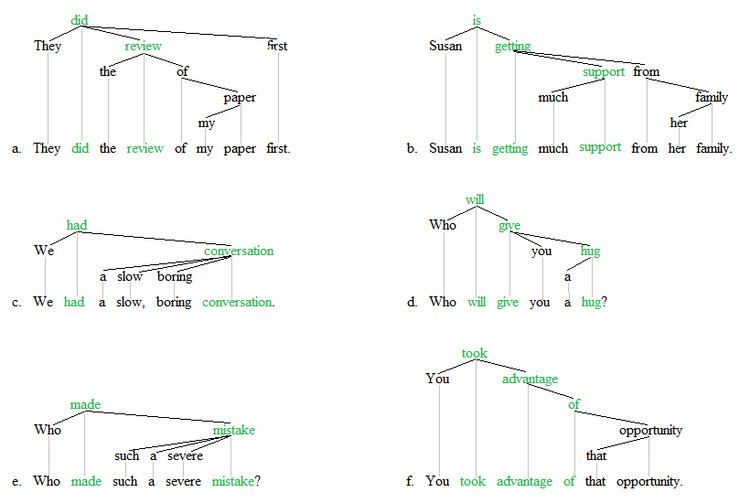 | ||
In linguistics, a light verb is a verb that has little semantic content of its own and forms a predicate with some additional expression, which is usually a noun. Common verbs in English that can function as light verbs are do, give, have, make, take, etc. Other names for light verb include delexical verb, vector verb, explicator verb, thin verb, empty verb or semantically weak verb (a semantically weak verb is not to be confused with a weak verb of the Germanic weak inflection, however). While light verbs are similar to auxiliary verbs regarding their meaning contribution to the clauses in which they appear, light verbs fail the diagnostics that identify auxiliary verbs and are therefore distinct from auxiliaries.
Contents
- Examples
- Alternative constructions with full verbs
- Vs auxiliary verbs and full verbs
- Compositionality in terms of catenae
- In other languages
- Diachronic considerations
- References
Light verb constructions challenge theories of compositionality because the words that form such constructions do not together qualify as constituents although the word combinations qualify as catenae.
Examples
Most light verb constructions in English include a noun and are sometimes called stretched verbs. Some light verb constructions also include a preposition, e.g.
The light verbs are underlined, and the words in bold together constitute the light verb constructions. Each of these constructions is the (primary part of the) main predicate of the sentence. Note that the determiner a is usually NOT part of the light verb construction. We know that it is not part of the light verb construction because it is variable, e.g. I took a long/the first/two/the best nap. The light verb contributes little content to its sentence; the main meaning resides with the noun in bold.
Alternative constructions with full verbs
Many light verb constructions are closely similar in meaning to a corresponding full verb, e.g.
Alternative formulations such as these lead to the insight that light verb constructions are predicates just like the corresponding full verb alternatives. There can be, however, nuanced differences in meaning across these alternative formulations. The light verb constructions produce possibilities for modification that are less available with the corresponding full verb alternatives.
Vs. auxiliary verbs and full verbs
Many verbs that serve as light verbs can also serve as auxiliary verbs and/or full verbs depending on the context in which they appear. Light verbs are similar to auxiliary verbs insofar as they contribute mainly functional content (as opposed to semantic content) to the clauses in which they appear. Light verbs, however, are not auxiliary verbs, nor are they full verbs. Light verbs differ from auxiliary verbs in English insofar as they do not pass the syntactic tests that identify auxiliary verbs. The following examples illustrate that light verbs fail the inversion and negation diagnostics that identify auxiliary verbs:
Light verbs differ from full verbs in that light verbs lack the semantic content that full verbs have. Full verbs are the core of a predicate, whereas light verbs form a predicate with another expression (often a noun) with full semantic content. This distinction is more difficult to illustrate, but it can be seen in the following examples involving reflexive pronouns:
The indices indicate coreference, i.e. the two coindexed words denote the same person. The reflexive pronoun must appear with the light verb, whereas the full verb allows the simple pronoun to appear as well. This distinction has to do with the extent of the predicate. The main predicate reaches down into the noun phrase when the light verb appears, whereas it excludes the noun phrase when the full verb is present.
Compositionality in terms of catenae
Light-verb constructions present the same difficulty associated with idiosyncratic expressions of every sort: the meaning is not compositional in a straightforward way. This fact is evident in the examples above, inasmuch as the words that constitute a light-verb construction often do not qualify as a constituent in any sense. These constructions do, however, form catenae (= chains). This fact is illustrated with the following dependency grammar trees:
The words of each light-verb construction form a catena. In this regard, the words in green qualify as the main predicate of the clause each time. If an auxiliary verb is present (as in trees b and d), it is included in the main predicate because like the light verb, it contributes functional meaning only.
In other languages
Examples in other languages include the Yiddish geb in geb a helf (literally give a help, "help"); the French faire in faire semblant (lit. make seeming, "pretend"); the Hindi nikal paRA (lit. leave fall, "start to leave"); and the bǎ construction in Chinese. Light verbs are extremely common in Indo-Iranian languages, Japanese, and other languages in which verb compounding is a primary mechanism for marking aspectual distinctions. Light verbs are also equivalent to inherent complement verbs in many Kwa languages e.g. jo in jo foi "run" Ga, tu in tu fo "advise" in Akan.
Diachronic considerations
Light verbs are interesting to linguists from a variety of perspectives, including those of diachronic linguistics and computational linguistics. From the diachronic perspective, the light verb is said to have evolved from the "heavy" verb through semantic bleaching, a process in which the verb loses some or all of its original semantics. In this sense, the light verb is often viewed as part of a cline:
verb (heavy) → light verb → auxiliary verb → clitic → affix → conjugationIn computational linguistics, a serious challenge is that of identifying light verb constructions, which require marking light verbs.
